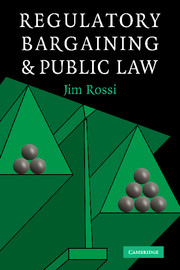Book contents
- Frontmatter
- Contents
- Preface
- Acknowledgments
- 1 The Scope of Regulatory Bargaining
- PART I EXTENDING INCOMPLETE BARGAINS FROM THE ECONOMICS OF THE FIRM TO PUBLIC GOVERNANCE
- PART II INCOMPLETE REGULATORY BARGAINS, INSTITUTIONS, AND THE ROLE OF JUDICIAL REVIEW IN DEREGULATED INDUSTRIES
- References
- Index of Primary Legal Authorities
- Subject Index
- References
References
Published online by Cambridge University Press: 11 July 2009
- Frontmatter
- Contents
- Preface
- Acknowledgments
- 1 The Scope of Regulatory Bargaining
- PART I EXTENDING INCOMPLETE BARGAINS FROM THE ECONOMICS OF THE FIRM TO PUBLIC GOVERNANCE
- PART II INCOMPLETE REGULATORY BARGAINS, INSTITUTIONS, AND THE ROLE OF JUDICIAL REVIEW IN DEREGULATED INDUSTRIES
- References
- Index of Primary Legal Authorities
- Subject Index
- References
- Type
- Chapter
- Information
- Regulatory Bargaining and Public Law , pp. 241 - 256Publisher: Cambridge University PressPrint publication year: 2005



